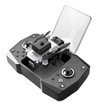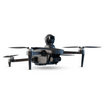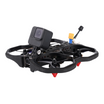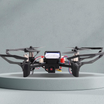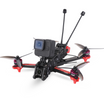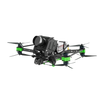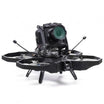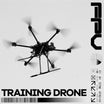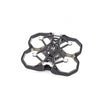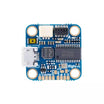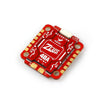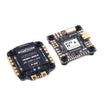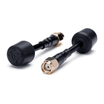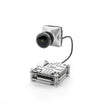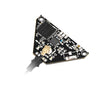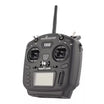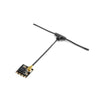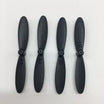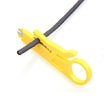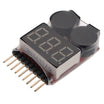Ever gazed at a drone gracefully carving through the air, capturing breathtaking landscapes from impossible angles, and wondered: how do high-flying marvels of modern technology defy gravity? The answer lies in a fascinating interplay of physics, engineering, and the magic of aerodynamics. The ability to soar through the skies, capturing breathtaking aerial footage or simply exploring unseen vistas. In this exploration of drone aerodynamics, we not only unravel the principles behind their flight but also delve into the sophisticated aerodynamic design of a drone that pushes the boundaries of what's possible in aerial technology.
The Essence of Drone Aerodynamics
Since the first quadcopters took to the air over a decade ago, drone flight has evolved from unstable experiments to precision aerial feats that defy imagination. Yet most casual observers fail to appreciate the incredible science and engineering that enables multirotor drones to lift off and manoeuvre with such grace.
Physics Sets the Foundation
Modern drones leverage decades of aerospace research converging around four primary scientific domains:
Aerodynamics: The study of forces and resulting motion as air interacts with solid bodies in relative motion. This covers drone component shapes, propeller designs and how frames travel through air.
Thermodynamics: Exploring relations between heat, mechanical energy and other forms of power. From battery chemistries to motor winding efficiencies, thermal design hugely impacts flight.
Electromagnetics: Governing how charged particles create, interact with and propagate electromagnetic fields. Radio links between transmitters, receivers and onboard processors fall under electromagnetic theory.
Control Theory: Techniques managing system behaviours and states by manipulating inputs over time. Drone programming for navigation, auto-stabilisation and payload management depend on highly advanced control algorithms.
While each area merits deep exploration, we’ll focus on their collective synergy enabling the incredible mobility that defines drones today.
Generating Lift Against Gravity
Sir Isaac Newton summarised the purpose of all drones, in his well-known second law
Force = Mass x Acceleration.
In basic flight terms, a quadcopter’s accelerating rotors must produce sufficient upward force exceeding its own downward gravitational force to leave firm land.
But how do relatively small propeller systems mounted on lightweight frames generate adequate thrust for sustained lift? The answer lies in clever aerodynamic and electromagnetic optimization.
Aerodynamics: Making Air Move Fast
A spinning aircraft propeller constitutes an airfoil that deflects oncoming airflow, resulting in an equal and opposite reaction force vector. Rotor blades utilise this principle to displace significant air volume downwards by accelerating local flow velocities.
Greater acceleration induced on surrounding air particles directly correlates with the magnitude of lifting forces produced vertically. So optimising blade contours, pitch angles and rpm ranges creates much larger pressure differentials - pulling drones upwards firmly against gravity.
Electromagnetics: More Spin, More Thrust
While airfoils set the aerodynamic stage, electromagnetic fundamentals power the staggering rpm rates quadcopter motors achieve. Applying an electric current to conductive motor windings generates rotational force between the fixed internal stator and output shaft rotor according to Fleming’s left hand rule.
Carefully designed stator-rotor air gaps concentrate magnetic flux while precision commutating sequences flip the polar direction of the rotating electromagnetic field. Combined result = intensely fast revolutions up to 100,000 rpm from coreless outrunner motors barely over an inch wide.
Torque & Tilts - Thrust Controls All Motion
Lift comprises only half the physics equation for controllable drone flight though. Manoeuvring anywhere purposefully also requires precise altitude adjustments plus lateral and rotational motion authority.
This boils down to adept manipulation of the thrust vectors produced by each rotor. Since torque and other blinding physics concepts seem to halt quadcopters mid mental takeoff though, let’s break down flight controls in simple terms:
Up/Down Movement = Throttle Control
Increasing or decreasing the rpm speeds of all four rotors simultaneously changes overall net thrust, allowing drones to ascend, hover or descend on command. Hand throttles on radio transmitters easily vary the voltage sent to electronic speed controllers. Gyro-assisted stability programming also auto-adjusts individual motors to maintain steady, level altitude against external disturbances like wind.
Tilting into Direction = Attitude Control
Changing rotor speeds asymmetrically tilts quadcopters predictably off level horizontal planes. Throttling the front and rear motors harder than the left/right pair pitches forwards/backwards respectively. Likewise, disproportionately speeding side motors roll the orientation left or right. This revised attitude shifts remaining lift vectors to begin actual translation.
Mastering precise attitude manipulation constitutes the artistry of manual flight! Certain stunts also exploit transient torque spikes from aggressive throttling manoeuvres.
Turning = Rotation Authority
Altering the counter-rotation rates between CW and CCW motor pairs imparts rapid heading changes to reorient drone directionality midair. This yaw torque control authority, often linked to rudder stick inputs, greatly expands navigational possibilities.
Taken together, clever combinations of vertical lift modulation, precise attitude angles and quick rotations fully empower freeform navigation in three dimensional space!
A Glimpse into Aerodynamic Excellence
Amidst the diverse range of drones available in the market, Elevate by insideFPV emerges as a standout example of aerodynamic innovation. Crafted with precision and equipped with advanced features, it offers more than just a means of capturing stunning visuals. Let's take a closer look at the standout features:
- High-Quality Aerial Photography:
insideFPV’s Elevate takes aerial photography to new heights with its cutting-edge camera technology. Sporting an impressive 20-million-pixel camera and a CMOS 1/3.06 sensor, it excels at capturing the minutest details in stunning clarity. It elevates the visual experience with its remarkable 4k HD video recording capability, bringing moments to life with unparalleled precision and vibrancy.
The lens of the drone enhances one's perspective with a broad 69° field of view (FOV) and an f/1.7 aperture. This combination ensures not only panoramic shots but also exceptional image clarity, even in challenging lighting conditions. Elevate doesn't just capture scenes; it crafts visual stories with every click. The blend of its advanced features and user-friendly design makes it easy for anyone to soar into the world of high-quality aerial photography, turning ordinary moments into extraordinary memories.
- 3-Axis Gimbal Stabilization:
In its quest for delivering unparalleled aerial cinematography, insideFPV’s Elevate boasts a sophisticated 3-axis gimbal stabilisation system, a technological feature designed to elevate your videography experience to new heights. It ensures that every frame captured is a masterpiece, characterised by a level of smoothness and professionalism that exceeds expectations.
The 3-axis gimbal stabilisation is the source behind Elevate's ability to produce cinematic footage with unwavering stability. Regardless of the challenges presented by turbulent conditions or high-speed flights, this innovative system brings a ballet of perfect movements. The gimbal ensures that the camera remains steadfast, capturing scenes with cinematic finesse.
This technological prowess becomes particularly evident in scenarios where other drones might falter. Elevate's gimbal stabilisation not only compensates for external forces but does so with an art that transforms ordinary shots into cinematic masterpieces. Whether navigating through brisk winds or executing dynamic activities, it stands as a steadfast steward, preserving the essence of each moment in your footage.
- Extended Flight Time:
Elevate's impressive flight capabilities are notably amplified by its robust 3100mAh battery, which plays a pivotal role in delivering an admirable 25-minute flight time. This extended endurance stands as a significant asset, empowering users with the ability to capture a wealth of content seamlessly, without the inconvenience of frequent battery changes.
The formidable 3100mAh battery serves as the powerhouse, ensuring sustained and prolonged flight sessions. This enhanced flight duration becomes particularly advantageous in various scenarios, whether it's capturing breathtaking aerial vistas, surveying landscapes, or engaging in immersive FPV experiences.
In the realm of aerodynamics, the prolonged flight time becomes a testament to the synergy between power efficiency and design precision. Elevate not only defies gravity but does so with a flight power that extends the boundaries of what drone technology can achieve.
This extended flight capability positions Elevate as more than just a drone; it becomes a reliable companion for enthusiasts and professionals, offering the luxury of time in the sky to explore, create, and savour the full spectrum of aerial possibilities. In the dynamic world of FPV, where every second in the air counts, Elevate's extended flight time becomes a distinguishing factor, elevating the overall experience for pilots and content creators.
Elevate in Action: Unleashing the Potential
Now that we've explored the specifications of Elevate, let's visualise how these features translate into real-world applications. From capturing cinematic footage in bustling urban areas to documenting the serene landscapes of open fields and meadows, Elevate proves its versatility. The drone's optimal operating temperatures from -10° to 40° C make it suitable for various environments, including deserts, mountains, and outdoor spaces.
The Future of Drone Aerodynamics
As technology continues to advance, the future of drone aerodynamics holds exciting possibilities. From improved battery efficiency to more streamlined designs, the evolution of drones is set to redefine our aerial experiences. Whether it's for recreational purposes, professional content creation, or innovative applications in various industries, drones like Elevate pave the way for a new era of aerial exploration.
In unravelling the intricacy drone aerodynamics, a captivating fusion of science and engineering unfolds before our eyes. Elevate emerges as a testimony to showcasing the extraordinary possibilities when cutting-edge technology merges with precise aerodynamic design. As we venture deeper into the detailed science of drones, we are not merely spectators to the marvels of flight; we are looking at the view of limitless potential.
It transcends the boundaries of conventional flight, inviting us to dream beyond the skies. So, the next time you look up and see a drone gliding through the sky, remember, it's not just defying gravity. It's a mark of endless possibilities, all powered by the amazing magic of aerodynamics.
Frequently Asked Questions (FAQs)
- How do drones fly?
Drones leverage aerodynamic principles, including lift, thrust, drag, and weight. Understanding these forces is crucial for comprehending how drones achieve controlled flight.
- Is it possible to fly a drone on the moon?
Drones are designed for Earth's atmosphere and rely on air to generate lift. As the moon lacks an atmosphere, the aerodynamics essential for drone flight wouldn't apply, making it currently impractical for drones to fly on the moon.
- Can a drone fly in the rain?
insideFPV’s Elevate comes with an IP53 rating, indicating protection from limited dust ingress and water spray less than 60 degrees from vertical. While it's designed to handle light rain and water spray, it's crucial to follow recommended guidelines. Flying in heavy rain should be avoided, but Elevate is generally suitable for mild weather conditions when precautions are observed.

